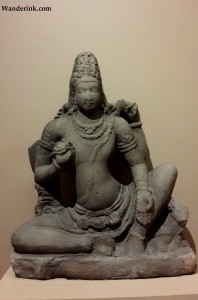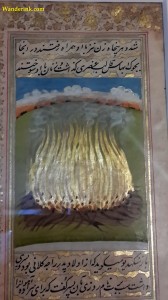Decapitated, defiled or deified, the human body has always enjoyed centre stage in Indian art. Whether the unabashed exploration of the sexual we see in the cave temples of Khajuraho or the unrelenting pursuit of the sacred depicted by the stupas of Bodh Gaya, the body has been the faithful transport. Quite understandably it is the pivot of celebrated ancient Indian treatises on desire and rejuvenation – the Kamasutra and Charaka Samhita, a basis of Ayurveda. And of course the medium of that ‘union with the divine’ the greatest Indian export of all times, yoga. But probably not so easy to understand is that it is this body which also stands in for the eternal and the ageless like the supernatural and reincarnates – which are essentially body-less.
This comparison to or cloaking with the human body was essential to ease the esoteric, often accomplished with an iconographic twist. Thus what we see as multiple heads and many sets of hands were actually ways of depicting ethereal beauty and supernatural prowess. But it was not always that you needed such astounding accoutrements to depict divinity; many a time it was achieved without much trouble, say with just an additional limb and probably a slightly elongated torso. The statue of Lord Shiva in the ‘The Body in Indian Art’ exhibition on at the National Museum in Delhi holds a rosary in one hand which shows the god’s prayerful side, another one has a drum which symbolises creation and a third hand gestures the varadamudra, which stands for divine dispensation of boons. While his broad chest holds the prana or breath of life, the long upper body represents the rising energy within. This eighth century statue from Karnataka is one of the 300 artifacts spanning over 4,000 years displayed at the exhibition which aims to reveal the body in its many representations ‘not just as a subject of art but as a keeper of values, preoccupations and aspirations of times ancient, medieval and modern.’
Little-known and seen masterpieces from all over India come together in this once-in-a-lifetime collection curated by Dr Naman Ahuja, a Delhi-based art historian and JNU professor. His research for the exhibition spanned over two decades and putting together the concept, design and sourcing the masterpieces took Ahuja almost two years. The exhibition originally opened at the Europalia cultural extravaganza at Brussels this year where it was lauded with international acclaim. Apparently because of the very stringent laws India has against shipping out ancient artifacts Ahuja met with some pretty bogging bureaucratic hurdles. To put the collection together – a large number of which are privately owned – Ahuja scoured the length and breadth of the country scouting for the image that would closely represent the religious and spiritual, philosophical and even intellectual posers ‘The Body’ throws up. As well as illustrate some attempts at answering them.
The exhibition features works from the second millennium BC to contemporary artists like Subodh Gupta and Mrinalini Mukherjee and is divided across eight galleries each exploring concepts like birth, rebirth, death, heroism, asceticism, the role of astrology in determining the fate of the body etc. The galleries have been juxtaposed in a slightly haphazard manner – could also be the exhibits that sort of, overflow – across the first floor of the museum but there are volunteers, mostly art and museology students, who will show you around in the manner preordained. In case you want to go it alone, like I did, what would seem like illogical dallying at first – alerting the omnipresent guards in the process – will turn out to be eventually more enjoyable, making you more au fait eventually with more than the layout.Probably as a grim reminder of the fate of the body is the starting theme – death – where one of the earliest exhibits, a page from the diary of an 18th century traveller into Rajasthan, had my boat afloat. A gouache, a bit childish perhaps, but quite frightfully succeeding in capturing the mass sati which it depicted. I don’t know which was more haunting – the crisscrossing sticks which looked like human bodies dragged into the pyre or the blobs in the flames which looked like heads. Struck me as the definitive ancestor of blogging and reality television. A 13th century Kakatiya sculpture of a soldier gutting himself is macabre in its detailing, all the more gruesome when you consider the frivolity with which self-inflicted death was dealt with during ancient times: a heroic passing into a realm where you have the choicest virgins and best of everything.
Most of the galleries feature artifacts from different religions – Hinduism, Jainism, Sikhism, Islam and even Tantric. There are also engrossing installations from the simple video streams to multi art. An LCD projector shows in loop the ‘Hola Mohalla’ the famous sporting event of the Nihangs – an armed Sikh order – interspersed with interviews with the daredevils themselves which traces the growth of a once-pacific army to a cult with clout. An installation exploring ‘aesthetic continuities between music and its visual depiction’ was the most sensual experience I had in recent times, with my clothes on. Through attached headphones, listen to the Raga Devagandhara, an early morning raga, while you peer closely at its visual depiction – pretty female devotees paying coy obeisance to a Shiva linga – and you enter the (time) frame. Instead of the temple with the linga, the raga is usually characterised by a sage in his hermitage visited by a woman; the voice of Padmabhushan Dr Shanno Khurana is so mellifluous and pleasurable that it unfetters imagination.
The wood statue of demoness Putana with Lord Krishna is ingenious, a mesmerisingly deviant piece of creativity fabulously in sync with the subject: She is dually positioned from the hip; sitting while suckling Krishna and supine after she dies. Nostalgia washed over me at the ‘body heroic’ gallery where one exhibit was quite amusingly enlarged pages from Amar Chitra Katha – the muscular kings had me eyeing the gym even before Salman Khan. The year-glass queens could give even Jen Selter a run for her Nike. ‘Jnana Chaupar’ an ancient form of snake and ladder shows us how actually we have dumbed down over the years. Being a hemp enthusiast I was particularly taken by Mrinalini Mukherjee’s ‘Basanti’, dyed hemp cascading in labiate folds which ‘alluded to the fructifying forces of nature.’
For those unable to visit the exhibition get the closest you can by requesting a catalogue by mailing to nationalmuseumoutreach@gmail.com. Even otherwise a great keepsake as such exhibitions are once-in-a-lifetime.
The exhibition is on till June 7, 2014. The National Museum in Janpath, New Delhi, is open from 10 AM to 5 PM and till 8 PM on Fridays; closed on Mondays.



















Sounds wonderful. The descriptive skills going a long way to enthuse personal experience.
You should do it… have convinced them to keep it going till June 7. Make it. 🙂
Detailed post. Good to know about the exhibition.
It’s really once/mebbe twice, in a lifetime. Worth it.